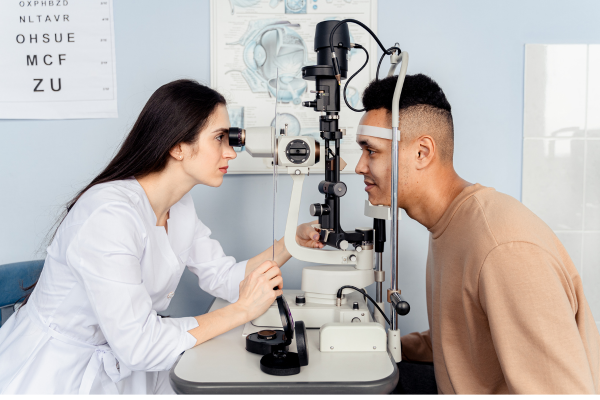Introduction
A Bachelor of Optometry (B.Optom) is an undergraduate degree program that focuses on eye care, vision health, and the diagnosis and management of eye diseases. Here are the key details of the course:

Program Structure
The Bachelor of Optometry is typically structured as a four-year professional degree (with some programs including an additional year for a clinical internship) designed to provide both academic knowledge and hands‐on clinical experience. Key features include:
- Foundational Years: The first two years focus on the basic sciences—human anatomy, physiology, biochemistry, physics, and general optics—laying the groundwork for understanding the eye’s structure and function.
- Specialized Optometric Courses: Subsequent semesters introduce subjects specific to optometry, including ocular anatomy, ocular physiology, visual optics (both geometrical and physical), and pharmacology, along with courses in clinical techniques, binocular vision, contact lens fitting, and low vision rehabilitation.
- Clinical Training: The later phase of the program emphasizes patient care and clinical reasoning. Students participate in supervised clinics and complete internships or externships at tertiary eye care centers, ensuring they gain practical experience before graduating.
Curriculum
The curriculum is carefully designed to cover a broad range of topics that prepare students to become competent primary eye care providers. Key components include:
- Basic Sciences: Courses in general human anatomy, physiology, biochemistry, and microbiology provide essential knowledge about the body that is later applied to understanding ocular structures.
- Ocular Sciences: In-depth courses on ocular anatomy and physiology, ocular pharmacology, and pathophysiology help students learn about the eye’s structure, function, and common diseases.
- Optics and Visual Sciences: Subjects such as geometrical and physical optics, visual perception, and refractive error correction are central to developing the skills needed for accurate refraction and prescribing corrective lenses.
- Clinical Optometry: Practical modules in clinical optometry cover diagnostic techniques, patient examination methods, case history taking, and clinical decision-making.
- Special Topics: Additional areas may include binocular vision, pediatric and geriatric optometry, low vision rehabilitation, public health, and practice management.
Competency Development
Modern optometry education is increasingly competency-based. Graduates are expected to develop both technical skills and professional attributes that enable them to deliver comprehensive eye care. Key competency areas include:
- Refractive and Dispensing Skills: Ability to assess refractive errors and prescribe spectacles and contact lenses accurately.
- Clinical Examination and Diagnosis: Proficiency in conducting thorough eye examinations—including anterior and posterior segment assessments—and in identifying ocular diseases.
- Patient Management: Competencies in clinical decision-making, effective communication, record-keeping, and managing referrals are emphasized.
- Public Health and Professionalism: Graduates learn to appreciate the social determinants of eye health, advocate for community eye care, and adhere to ethical and legal standards in practice.
- Adherence to International Frameworks: Many curricula align with global competency models such as those established by the World Council of Optometry (WCO), which group required skills into domains like practice, professionalism, learning, management, community advocacy, and evidence-based care.
Career Pathways
Graduates of a Bachelor of Optometry have a wide variety of career opportunities available in both clinical and non-clinical settings. These include:
- Primary Clinical Practice: Many optometrists work in private practices, hospitals, or community health centers providing primary eye care services.
- Specialized Optometry: Opportunities exist to specialize in fields such as pediatric optometry, low vision rehabilitation, contact lens management, or occupational and sports vision.
- Optical Retail and Industry: Some graduates choose to work in optical manufacturing, retail management, or as consultants in the design and dispensing of optical aids.
- Academia and Research: For those interested in teaching or conducting research, academic positions at optometry schools or research roles in vision science laboratories are viable paths.
- Public Health: Graduates can also work with governmental or non-governmental organizations to implement community outreach, vision screening programs, and health education initiatives.
Job Titles
Depending on their area of specialization and work setting, graduates may assume various job titles such as:
- Optometrist: The primary title for graduates providing comprehensive eye examinations and vision care.
- Contact Lens Specialist: Focusing on fitting, prescribing, and managing contact lens therapy.
- Vision Therapist or Binocular Vision Specialist: Working with patients who have amblyopia or other binocular vision disorders.
- Pediatric or Geriatric Optometrist: Specializing in eye care for children or the elderly.
- Low Vision Rehabilitation Specialist: Assisting patients with significant vision impairment to maximize their remaining vision.
- Optical Consultant or Dispensing Optician: Often involved in the selection, fitting, and dispensing of eyewear.
- Research Associate in Vision Science: Engaging in academic or industrial research projects related to optometry.
Conclusion
The Bachelor of Optometry course is a robust, four-year program (often with an additional internship year) that equips students with a balanced mix of foundational sciences, specialized optometric knowledge, and extensive clinical training. By fostering both technical and professional competencies—aligned with international standards such as the WCO Competency Framework—this program prepares graduates to serve as primary eye care providers in a rapidly evolving healthcare landscape. With diverse career pathways and a wide range of job titles, graduates are well positioned to make a significant impact on public health, contribute to clinical advancements, and meet the growing global demand for quality eye care.
THANK YOU.

